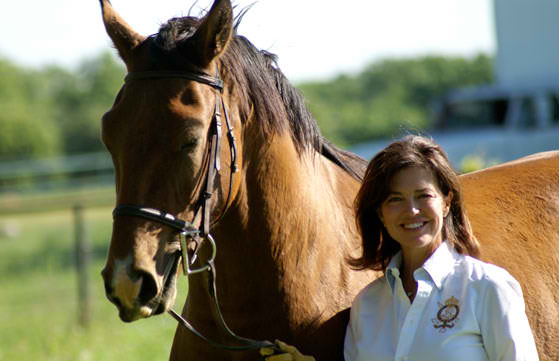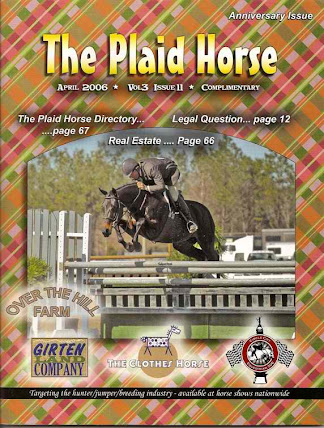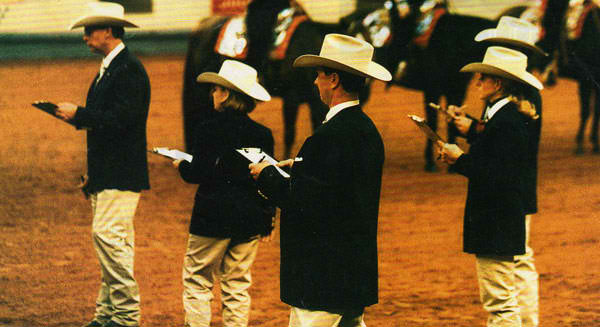|
Equi-Notes Issue #22 March 13, 2013
|
|
|
|
Dear Friends of Equines, Thank you for taking the time to check out our newsletter. We hope you enjoy this edition .If you're tweeting, please visit and follow our twitter page . We appreciate it! Sincerely, Jacquelyn Leuener~ Equi Partners, LLC |
|
 |
So You Are Thinking About Donating Your Horse
 | | Bridget & home bred~Journey |
Equi-Partner~Bridget Brandon
ASEA Certified Senior Equine Appraiser and Expert Witness
Tel. (817) 454-4537 Texas, USA ValueMyHorse.com
Bridget and I thought it would be informative to present a series of articles over the next few issues. In honor of tax season, we decided to start off with what to do when donating a horse. Bridget offers some insight on the process.
Donating a horse can be a great way to place your beloved horse into a home where they will be well cared for and loved and you will be providing a valuable service to a non-profit organization. I have had many individuals ask me what is involved in donating a horse and there are a few things you should know. When you donate a horse, you must:
- Complete IRS Form 8283. If the horse is valued at more than $5,000.00, you must have a certified equine appraiser appraise your horse and sign IRS Form 8283.
- Make sure the organization is a nonprofit charity qualifier under the Internal Revenue Service (IRS) Code 501 (c) (3) - exempt from taxation because its income derives from its educational, religious, charitable, or humanitarian purpose. You may contact the IRS for a listing of qualified 501 (c) (3) organizations. You may also ask the non-profit to see its Statement of Purpose and IRS Exemption Certificate.
There are options for donating your horse today. Please be sure to thoroughly research the non-profit you are making the donation to.
How to Find An Appraiser
There are various avenues to locating a certified equine appraiser. You can contact the ASEA (American Society of Equine Appraisers) (www.equineappraiser.com).
The ASEA offers two types of memberships levels, accredited members and senior level members.
- An accredited member is an individual with prior or current experience working with horses and has met ASEA certification criteria.
- A senior appraiser is an accredited member who has completed the appraisal courses given by the ASEA and meets the minimum qualification criteria for certification as personal property appraisers established by the Appraisers Qualification Board (AQB). The AQB certification process requires applicants to meet certain education and experience requirements, which involves 120 classroom hours and 700 field hours; additionally, members need to fulfill continuing education requirements every five years to maintain their senior appraiser status.
 | |
Bridget with one of her foals
|
Not all horses are created equal and not all appraisers are created equal.
By that I mean it is important to find an appraiser that understands your
horses' breed and discipline as there are nuances that can affect it's value. It's ok for an appraiser to have assistance from another appraiser, but they must state the name of the appraiser who assisted in their report. Be wary of appraisers that claim they are an expert in "All Breeds and All Disciplines".
I recommend that you request a signed work agreement with the appraiser and be sure to request the fee schedule up front. The more information you can provide the appraiser, the better they are able to provide an accurate report on your horse. And, most appraisers will not release a report until payment has been made in full. If an appraiser is not willing to provide references or sign an agreement, find another appraiser.
I always advise and teach clients how to keep very detailed and excellent records of their horses! You may not be planning on donating a horse, but unfortunately, you may need an appraiser for other reasons such as a law suit, divorce, estate settlement, etc... It's best to be prepared and protect yourself because horse ownership is not inexpensive! ~Bridget is also a successful breeder of Oldenburgs and has shown Hunter Jumpers for many years. Her foals are well sought after. Thanks Bridget for the education and passion for horses!
 | | Sinners Prayer, Owned by Bridget Brandon, Cover of Plaid Horse |
 | |
Bridget and CR Andiamo
|
*ValueMyHorse is not an expert in Tax law and highly advises you discuss your personal situation with your accountant and/or tax attorney. Every non-profit has their own requirements and it is important to understand how those requirements affect your personal situation. Your accountant or tax attorney can assist you with structuring your contract with the non-profit to give you the best tax benefits.
|
Tips for Showing Western
 | |
Mark Sheridan~Cave Creek, AZ
|
Mark offers a series of articles to give helpful advice on what to do correctly to raise your score and help you with getting to the next level in horse showing. He also wants to make sure that he gives plenty of ideas on what NOT to do!
"There are so many times when I am judging and want to just get up and help someone with their ride. That is the trainer and coach in me. Many times I will say to my self, "If they just didn't do that particular thing in their pattern, it would have gone so much better." JUDGE SHERIDAN'S PET PEEVES There are also times where the level of competition is above average at many weekend shows. Riding a clean mistake free pattern can land you close to the top without having a prefect ride.  | |
AQHA World Show 2010
|
Every judge has pet peeves, likes and dislikes. I would say that my biggest issue is using the spur stop on a loose rein and only riding the horse with your legs.This includes riding the horse in the pattern or on the rail with the spur brake to adjust your speed, and having your horse canted too far with his hip to the inside. Usually when this happens, the horse will not move correctly in a three beat cadenced lope. Spur stopping your horse will also push your knees out and you will loose contact with the sides of your horse as well as creating unnecessary space between your leg and the barrel of the horse. An extremely loose set of reins will create additional lack of communication with the horse. One will also have to raise their hands way too far in able to reach the mouth of the horse when picking up on the reins. I understand that the western pleasure class has created some of this, however horsemanship is an entirely different event. Many exhibitors will also draw their horses down to the trashy slow lope which will make it easier for them to sit the saddle quieter. I understand the thought process in this concept, but I want to reward proper movement at all three gaits.
It is necessary for horses that do the trail event to have a spur stop on them to be able to lope into a six foot box and stop properly and suddenly without pulling on their mouth to avoid
 | | Mark Sheridan-AQHA World Show |
stepping out of the box. I also feel that having more buttons on your horse is a good thing as long as you do not take it to the extreme. Riding your horse in the trail and western riding will require leg pressure to maneuver around obstacles freely without pulling on your horse's mouth. If your horse does have a spur stop, there is nothing wrong with gently picking up on the reins, squeezing with your legs, and using a soft verbal cue to halt. Reasonably loose reins are ok, as long as the exhibitor can remain light contact with the horse's mouth by picking their rein hand up a few inches. Total communication between horse and rider is what I personally look for. Hands, legs, and your seat used equally will make the communication for performance work great.
|
|
If you'd like to contribute to the news, please email us: jac@jackpotequine.com  Follow American Wild Horse Preservation Campaign
We need a win-win solution~ for the horses~for our rural heritage~ 
|
|
|
|
|
|
|
|